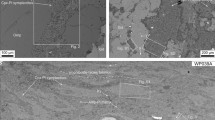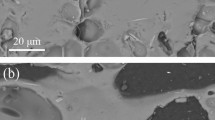Abstract
The Multiple Diffusion Domain (MDD) theory of Ar loss, based on the 40Ar/39Ar method, has been used to obtain thermal histories, over tens of millions of years, in the range 500 °C to near-surface temperatures, of alkali feldspars from slowly cooled geological environments and recovered in situ from sedimentary basins and geothermal systems. It assumes that Ar diffuses in Nature, over geological time, from the same domains, and by the same processes, that control its diffusion during laboratory step-heating experiments. Mathematically the model has many stringent requirements: the domains must form at T above those being modelled and must remain unchanged during geological time and during step heating, must not interact, must occur in discrete size ranges sharing one simple geometrical shape, contain no compositional gradients in 40K, and release Ar into an infinite reservoir. We describe the nature of possible diffusion domains, and the fast pathways for diffusion between them, known to exist in alkali feldspars from direct electron microscopic observations, and explore their time–temperature evolution, based on established phase behaviour, both over geological time and during step heating. Strain-controlled microtextures, whose morphology is controlled by the minimization of coherency strain energy, do not provide fast pathways for Ar loss, and behave as crystallographically complex but single domains for Ar. Subregular dislocations may form over a range of T in some strain-controlled intergrowths, but in Nature the majority form closed loops and do not provide pathways to the crystal surface. Deuteric microtextures cut across strain-controlled microtextures, and are composed of microporous subgrain and grain mosaics with many pathways and a wide spectrum of possible domain sizes and shapes. The deuterically altered zones provide pathways for Ar diffusion out of the crystal, although some Ar is retained in fluid inclusions. All microtextures likely to define diffusion domains form below 500 °C, over a range of T and (in slowly cooled rocks) of times. The most important involve fluid–feldspar reactions, which can reset Ar, and continue to surface T. Feldspars in geothermal systems and young sedimentary basins are subject to ongoing chemical and microtextural changes. Because the microtextures are metastable during step-heating experiments in the T range over which most Ar is released, domains and pathways for rapid diffusion of Ar between domains will be significantly modified during step heating, particularly above 750 °C, when departures from a simple Arrhenius diffusion law are most marked. Pre-melting is likely to be an important cause of complexity in Ar loss behaviour. Few, if any, of the requirements of the MDD model are met, and we conclude that thermal histories cannot be obtained from alkali feldspars using this method.
Similar content being viewed by others
Author information
Authors and Affiliations
Additional information
Received: 21 September 1998 / Accepted: 1 March 1999
Rights and permissions
About this article
Cite this article
Parsons, I., Brown, W. & Smith, J. 40Ar/39Ar thermochronology using alkali feldspars: real thermal history or mathematical mirage of microtexture?. Contrib Mineral Petrol 136, 92–110 (1999). https://doi.org/10.1007/s004100050526
Issue Date:
DOI: https://doi.org/10.1007/s004100050526




